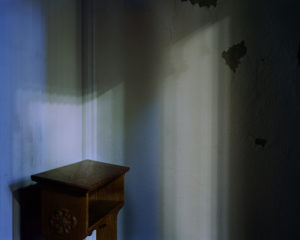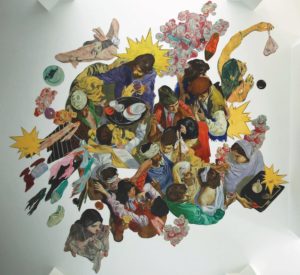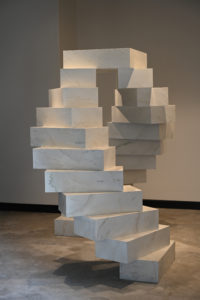IN 2020, THE ROTHKO CHAPEL ANNOUNCED its inaugural Spirituality and Social Justice Cohort, a project intended to “provide a platform for discourse on, and exploration of, the relationship between spirituality and social justice advocacy.” Among this initial group of eight pastors, academics, and nonprofit leaders, artist Caron Tabb offers a unique perspective by demonstrating how art can be a conduit between Jewish spirituality and social justice.
From Martin Luther King Jr. to the Dalai Lama, religious leaders have historically been leaders in the fight for social justice, but today that fruitful connection is at risk. Our current left-versus-right tribalism often pits two camps against each other: while popular media on the left tends to cast religious institutions as antagonistic to social change, the right frames progressivism as a threat to closely held values. This widening rift between faith or spiritual practices and progressive activist movements has myriad implications. Both religion without service and activism divorced from spirituality too easily become tools for othering that hinder empathy and compassion, exacerbating the tensions of our time.
Tabb’s blending of art and activism offers a compelling antidote. Her conceptual mixed-media and installation pieces examine issues of social inequality, racial justice, and feminism through the lens of her deep Jewish identity and her personal history as an immigrant, first from South Africa to Israel and later to America. She seeks out materials rife with metaphor—Jewish ritual objects, found objects, repurposed garments—then transforms them with paint, cement, fire, and text, with the goal of sparking dialogue, increasing empathy, and engaging in difficult conversations. The resulting works are deeply personal reflections that reflect her perpetual drive to use what privilege she has for good.
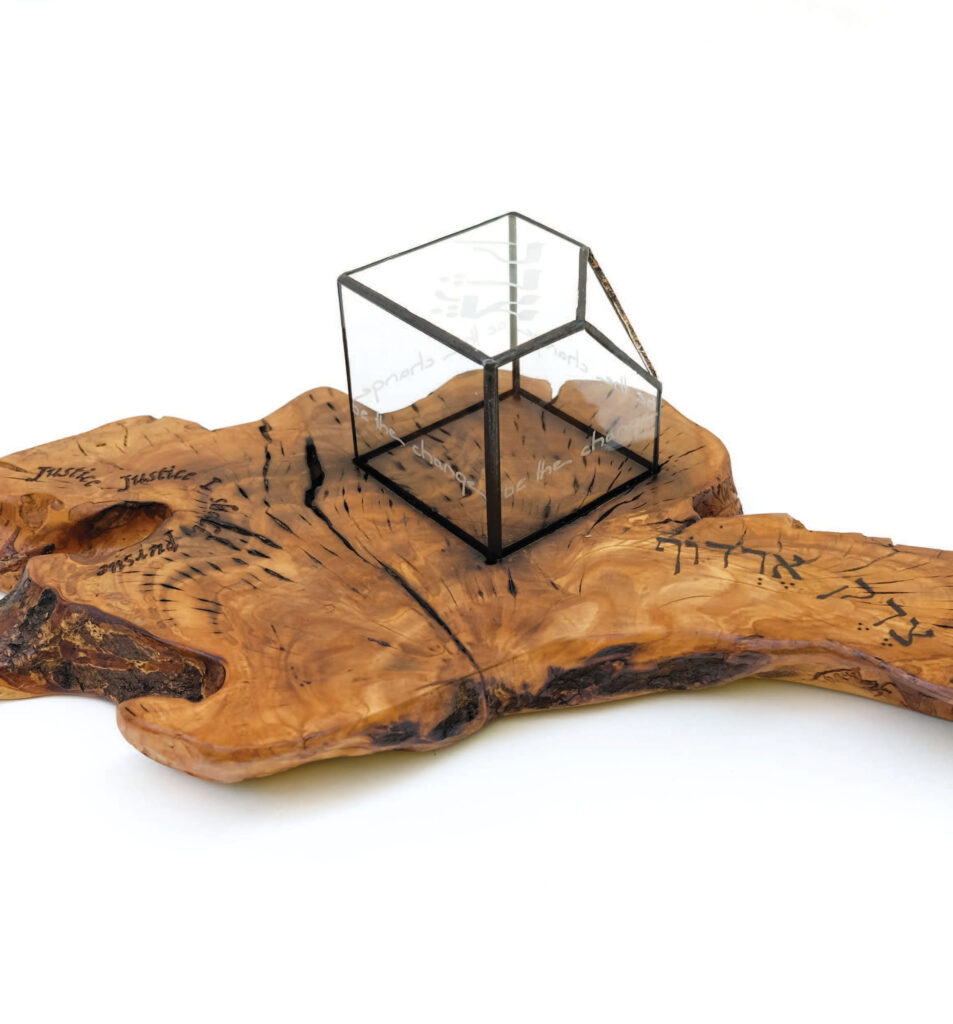
Caron Tabb. Justice Vessels, Tzedakah Boxes: Women of Valor; For Ruth, 2021. Etched glass, scorched olive wood from Israel. 6 x 22 x 11 inches. Photo: Emma Gelbard.
One of Tabb’s earliest works connecting her faith and activism is Let Us Pray. This monumental sculpture takes the form of a nearly ten-foot-tall tallit, a Jewish prayer shawl traditionally worn during morning prayer and on high holidays. Tabb sees it as a reminder of a higher power: “To wear the tallit is to cloak yourself in reverence to the divine. In a symbolic way, you are wearing your spirituality and being enveloped by it.” Tabb’s tallit is inscribed with the famous words of Jewish poet Emma Lazarus that adorn the base of the Statue of Liberty: “Give me your tired, your poor, / Your huddled masses yearning to breathe free.” Rather than the traditional 613 tassels (representing the 613 commandments Jews are expected to observe), Tabb’s version includes just thirteen, symbolizing the thirteen thousand immigrant children held in detention centers around the US on the day of the work’s completion. Here Tabb aims to present and enshrine a fundamental Jewish biblical tenet: caring for the stranger. She writes, “I encourage you, the viewer, to step into the tallit and feel the weight of this call to duty to care for strangers wherever they may need your assistance.”
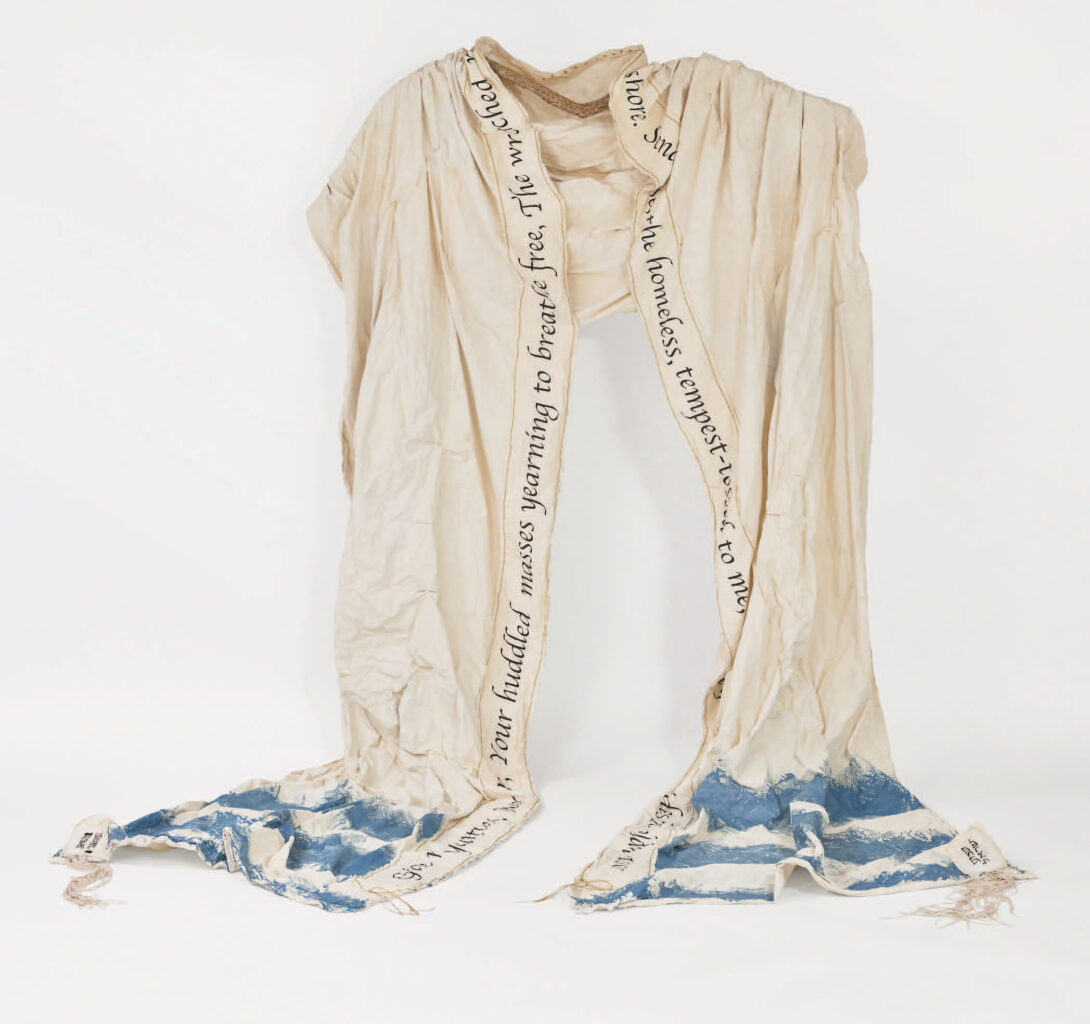
Caron Tabb. Let Us Pray, 2019. Acrylic, latex paint, thread, twine, tree bark, canvas, heat-set lettering, monofilament. 57 x 115 inches. Photo: Julia Featheringill.
On the one hand, Let Us Pray speaks to religious audiences, inviting them into secular spaces and empowering them to see familiar ritual objects in new ways and to reimagine the lessons they teach. Simultaneously, the piece engages audiences who have little experience with Jewish culture, introducing them to the values central to a religious practice that may feel foreign to them. For both audiences, the impetus is clear: no matter your religion, stepping under the tallit, you feel the weight of responsibility. Like much of Tabb’s work, this enormous garment creates space for viewers to confront questions about the relationship between faith and justice.
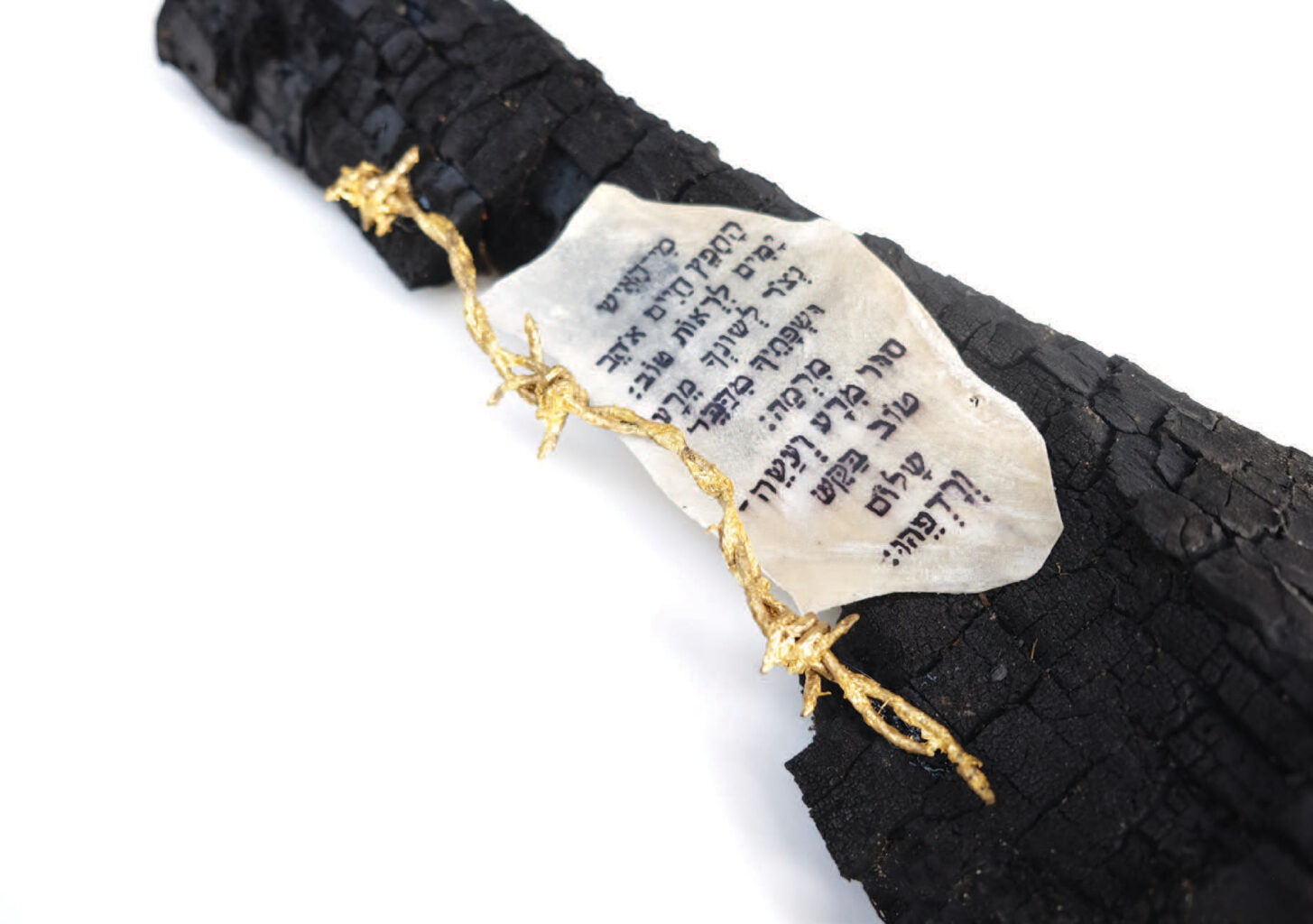
Caron Tabb. Psalms 34:14: Seek Peace and Pursue It, 2021. Scorched wood, 22-carat gold leaf, barbed wire, goatskin parchment, ink. 14½ x 6 x 4 inches. Photo: Emma Gelbard.
While Tabb mines her faith for inspiration, her work also exemplifies how art can critique religious institutions in a way that does not disavow them but encourages them to evolve. In Psalm 34:14—Seek Peace and Pursue It, Tabb reimagines another familiar Jewish ritual object, a mezuzah. Often affixed to the doorpost of a Jewish home, a mezuzah is a symbol to all who enter of the inhabitants’ Jewish identity and commitment. Traditionally, a mezuzah contains a scroll with two Torah passages that address the Jewish people’s covenant with God. In Psalm 34:14, Tabb replaces the traditional texts with a psalm verse that gives priority to relationships between humans: the imperative to work toward peace. Tabb comments: “For some, a strong relationship with God is foundational, but some now invoke religion to inflict harm on others. Here I am placing significance in the covenant between human beings rather than between human and divine.”
Tabb’s work strikes a balance between revering the teachings of her religion and pointedly criticizing it when it falls short. It’s a balance that reflects the dynamic relationship many people have with their faith traditions, Jewish or not. By creating works that allow for the deeply personal ways people incorporate spiritual teachings into their lives, Tabb empowers people of faith to speak out against injustices baked into their religious institutions while inviting us all to see the diversity within religious groups. In this way, her work shows how art can break down the social barriers that have sprung up between faith-based groups and progressive activist communities.
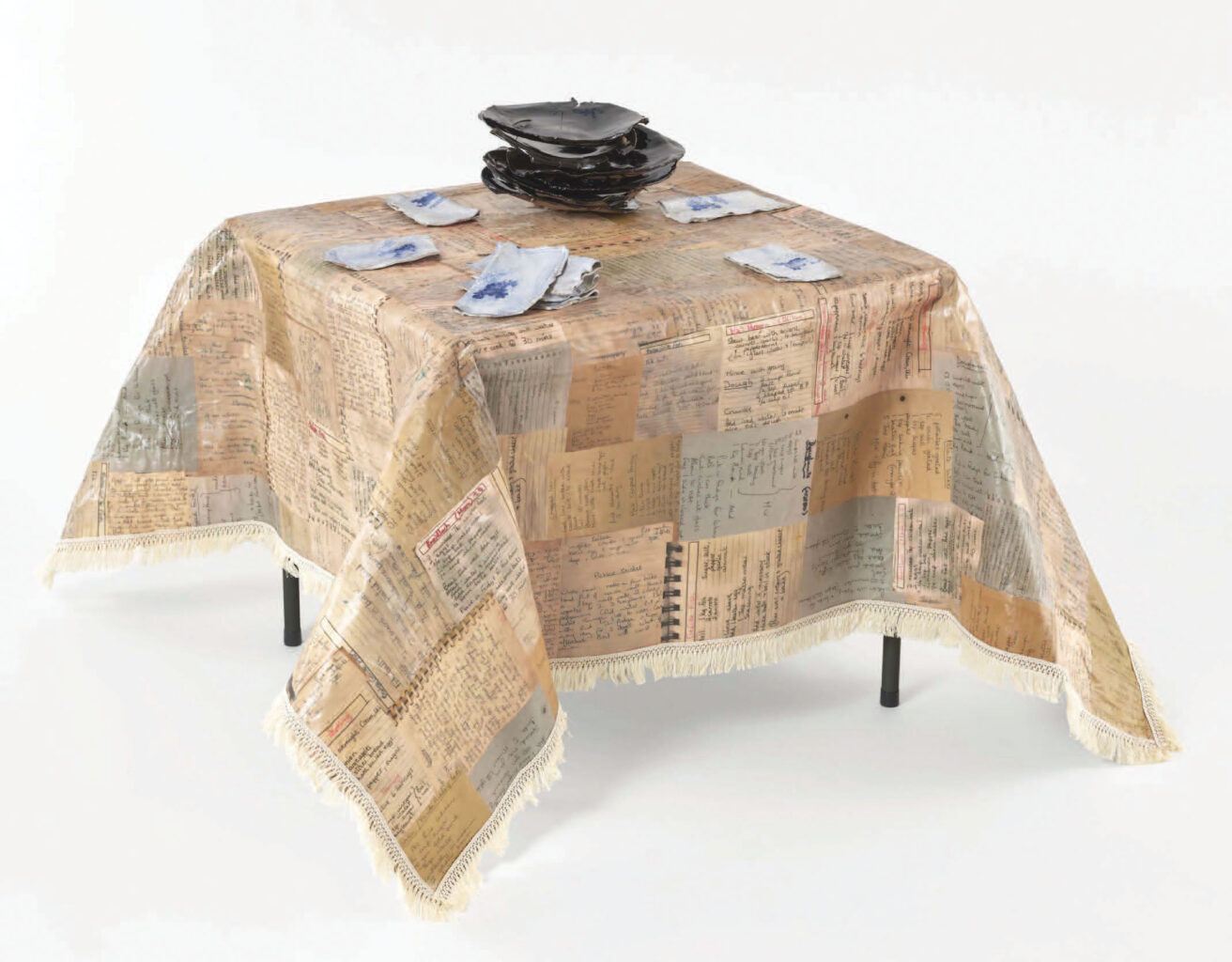
Caron Tabb. Around My Mother’s Table, 2019. Paper, fabric, ribbon trim, glazed clay. 28 x 34 x 34 inches. Both photos: Julia Featheringill.
Tabb’s work especially draws on women’s stories as a means of helping audiences find common ground. Ken Grossinger writes, “Tabb’s work helps to build narrative power—taking control of the stories and ideas that shape how we think about history, culture, people, and places.” For instance, Around My Mother’s Table features a tablecloth made from recipes passed down from her two grandmothers. This is Tabb’s way of bringing Shabbat dinners into the gallery, illuminating how those meals connect her to her past and draw her family’s history into the future. As framed by this work, Jewish traditions offer a reminder that Tabb is part of something larger than herself. In an interview, she described how this work underscores the distinction between spirituality and religiosity: “My Judaism is not rooted in prescriptions and restrictions. Rather, I feel most connected to a higher power when I tap into the values I share with other people, with my ancestors, with the next generation, and with people from all walks of life all around the world. To me, spirituality is about shared humanity.”
For Tabb, translating this sense of shared humanity into works of art often hinges on bringing individual stories to life. Often those to whom she feels most connected are women who dedicate their lives to serving others: “I am interested in elevating the stories of women who strive for justice and use what they have to give back to others.” Her series Justice Vessels, Tzedakah Boxes: Women of Valor consists of two sculptures, each dedicated to an activist Tabb admires. A tzedakah box (based on the root word tzedek, Hebrew for justice) is a small box for collecting loose change to be donated to those in need. Jewish tradition teaches that giving tzedakah is a religious imperative, even for those who have little to give. As the name suggests, the concept of justice, in Jewish tradition, is intimately tied to the act of giving, and conversely, the act of seeking justice is a form of giving that fulfills this central tenet.
In Women of Valor, Tabb reimagines these ritual objects, transforming them from humble collection boxes into vessels that honor two women who have used their power to improve the lives of others. They are Ruth Messinger, who served at the helm of the American Jewish World Service and helped shape that organization into a leader in humanitarian work around the world; and Chaplain Clementina Chéry, who founded and led the Louis D. Brown Peace Institute after losing her fifteen-year-old son to gun violence. These disquisitive objects, displayed in secular spaces, are meant to hold up these women as examples of what it means to give tzedakah. Their stories also highlight the universality of those values of generosity, service, and peacemaking, inviting viewers—religious or not—to reflect on the imperative to action that Tabb, Messinger, and Chéry each find in their different faith traditions.
Tabb’s tzedakah boxes debuted in her 2021 exhibition Humanity Is Not a Spectator Sport at Beacon Gallery in Boston. They sparked such rich conversation about how art can inspire people to act for justice that it spurred a multi-city public art and activism movement called Be the Change. This project, organized by Tabb in collaboration with the Boston-based Jewish Arts Collaborative, featured eighteen artists in three US cities who each created a large-scale public installation devoted to a social issue of their choosing. The goal for each work was to transform bystanders into activists.
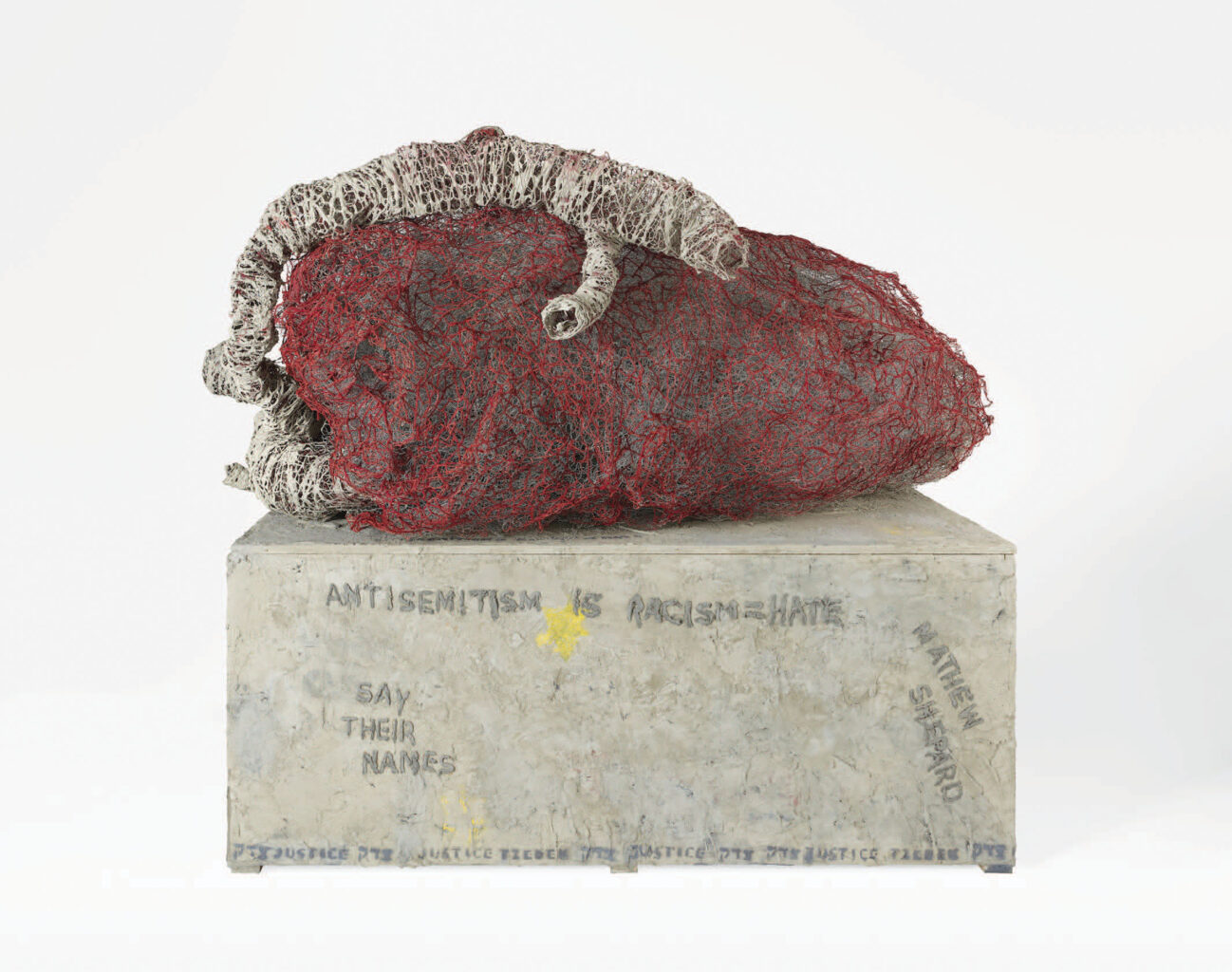
Caron Tabb. Prisoner a-7713: Antisemitism = Racism = Hate Sliding Back in Time Or, Did We
Actually Ever Move Forward? 2022. Chicken wire, concrete, yarn, paint, wood. 56 x 72 x 36 inches.
Tabb’s contribution to Be the Change took aim at the global rise of antisemitism and hate crimes. Titled Prisoner a-7713: Antisemitism = Racism = Hate Sliding Back in Time Or, Did We Actually Ever Move Forward? the sculpture takes the form of an eight-foot-long human heart made of fencing material and placed on a tomb-like concrete pedestal. Names, phrases, and symbols inscribed on the base work to categorize antisemitism as a form of racism. Tabb was in conversation with the Anti-Defamation League while creating the sculpture, and a central goal for her was to increase awareness of their work. A QR code accompanying the piece led to the organization’s donation page, a panel discussion at the exhibition featured a representative from the ADL, and all exhibition promotion focused on driving online and in-person audiences to directly support the organization’s efforts in fighting antisemitism.
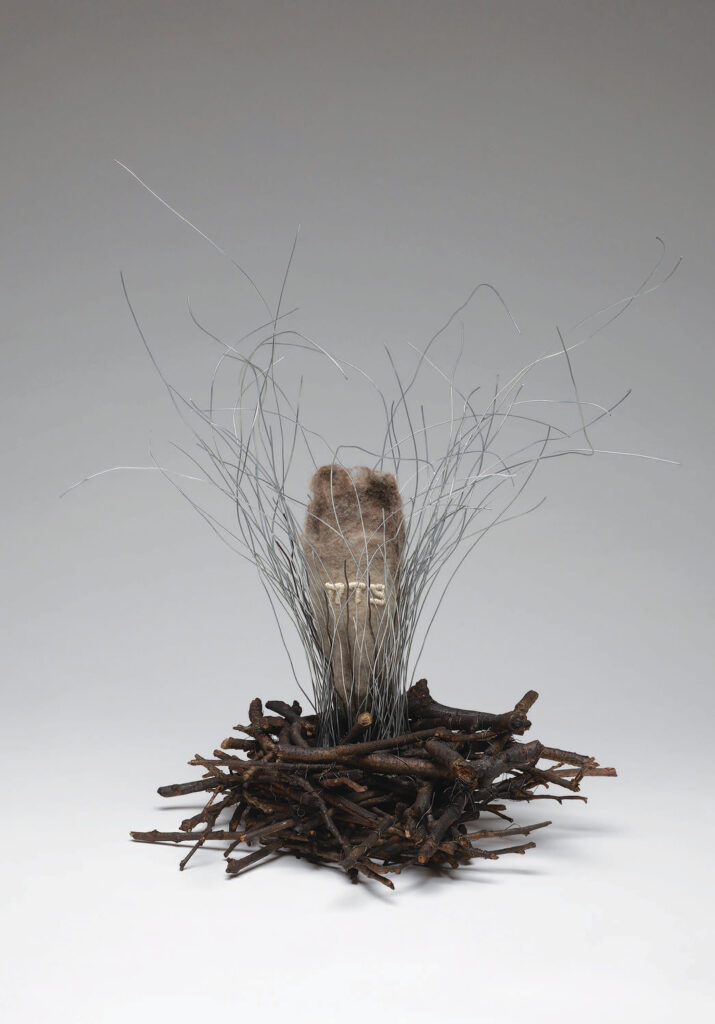
Caron Tabb. Justice Vessels, Tzedakah Boxes: Women of Valor; For Tina, 2021. Scorched tree branches, stainless steel, wool roving, thread. 22 x 16 x 16 inches. Photo: Julia Featheringill.
Through works like these, Tabb illustrates how the language of art can speak to both religious and secular people about the relationship between faith and justice. While, on the one hand, Tabb’s works serve as catalysts for direct action, offering a path for viewers to take part in causes she believes in, they also serve as meditations on living in one’s purpose. Using Judaism as a template, they invite viewers to connect with their own sense of a higher power and to explore how that power calls them to act. Tabb’s work showcases how her faith inspires her service of others, fighting for equal rights and opportunities for immigrants, women, and historically marginalized people. Her works welcome you to join her in that fight, while also creating space for you to choose your own battles, to find what calls you.
Casey Curry is a writer and curator whose research is rooted in thinking creatively about arts administration to uncover what is possible when artists are supported by administrative allies with complementary skills that level bureaucratic barriers.





